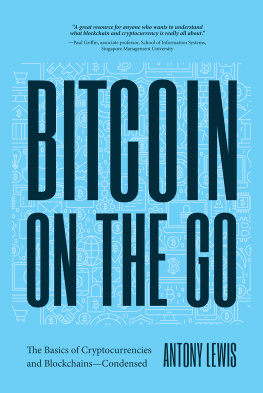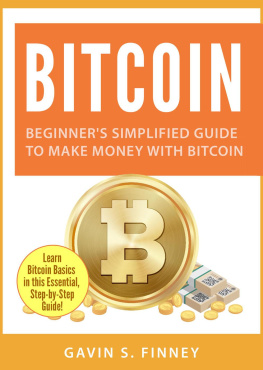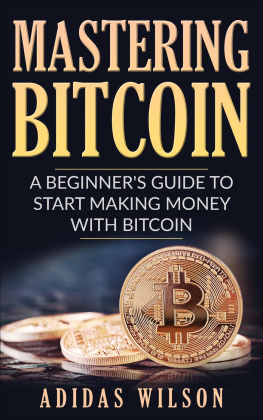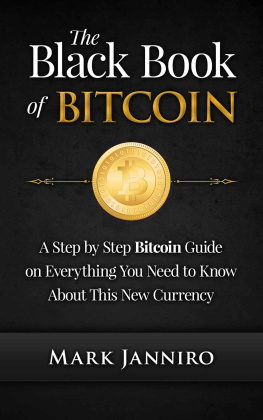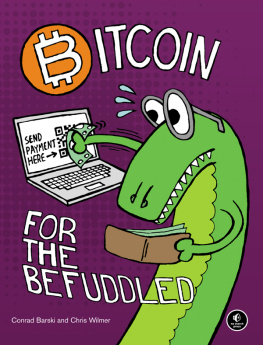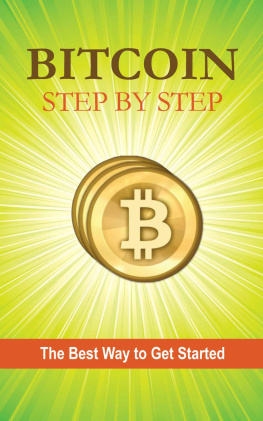Table of Contents
Introduction
Throughout history, the primary method of communicating with someone over long distances was sending a letter. This could take days, weeks, even months, with no guarantee the letter would arrive at all. Even then it was only one-way communication, for a conversation to take place it would take longer still.
Email changed communications drastically. Messages were sent and received instantly, from anywhere in the world. Before email, people didnt even recognize the drawbacks of the old communications system. Once email became widely adopted, the drawbacks were instantly obvious, and weve never looked back.
This is true of our current system of money today. Most people dont stop to think about the drawbacks of our current monetary system, but a new technology is already beginning to change that. This new technologycalled Bitcoinis rapidly changing the way we view money.
This guide will explain to you what Bitcoin is, give a laymans view of how it works, and explain exactly how you can obtain Bitcoin, store them safely, spend them, and even create them yourself. Bitcoin is a complicated subject, but in this guide I will give you everything you need to know in order to understand the system and get started.
What is Bitcoin?
When people say Bitcoin they are referring to one of two things.
A digital currency.
A payment system used for sending and receiving money online.
Typically the term is used to apply to the currency itself, but the payment system is every bit as important as the currency. Let me explain both.
Bitcoin as a Currency
Bitcoin is a digital, decentralized, peer to peer , pseudonymous currency based on cryptography. If that sentence made no sense to you, dont worry - Ill break it down for you.
Digital Bitcoins exist only as code, they do not exist as anything physical. People can (and have) made physical representations of Bitcoin, but ultimately they are based in the digital world.
Decentralized There is no central bank or institution that issues or controls Bitcoin. It is a group of individuals all over the world who run the program that keeps the monetary system running.
Peer to Peer You control your own Bitcoin, and when you send Bitcoin to someone else, it goes directly to them. There are no banks or middlemen.
Pseudonymous While all Bitcoin transactions are publically viewable in an open ledger called the Blockchain (well get to that later), the sender and receiver are only known as a string of numbers and letters. If youre careful about your identity, using Bitcoins can be done anonymously.
Based on Cryptography The strength of Bitcoin as a digital currency lies in the code, which uses strong cryptography to ensure that the coins cannot be accessed without proper permission.
Bitcoin is the first digital currency that has these characteristics, and as a result it is the first digital currency to become widely adopted on the internet. As of June 2013, it is handling nearly 60,000 transactions each day, and this number is accelerating quickly.
Bitcoin as a Payment System : Solving the Double Spend Problem
As a new digital currency, Bitcoin is impressive, but the truly revolutionary aspect of Bitcoin is in a new payment system. Before I explain this system, let me briefly describe one of the primary reasons why digital currencies have always failed in the past.
In the physical world, money cant be in two places at once: once you spend it, it is inside store As cash register and it cant be in store Bs cash register. With digital currency, this isnt necessarily true. Since digital currency is computer code, the same money could actually reside in multiple places. This is obviously a huge problem, and would lead to rampant fraud.
However, we do transact huge amounts of money digitally today, so how come we dont see more double spending? Well, we have services that take care of the problem, such as PayPal. They review all the transactions to ensure that the same money isnt spent twice.
But there are substantial problems with using a centralized service to deal with the double spend problem. First, they are a single point of failure. This means that if PayPal were to have technical problems or perhaps if they dont like what you are trying to purchase then you cant move your money at all. Also, you have to pay them for their service, typically with fees that are 2% or even higher.
Bitcoins payment system solves the double spend problem, does it without relying on a single point of failure, and requires substantially smaller fees. It does this by using a public ledger called the Blockchain, which Ill discuss in more detail later in the book.
History of Bitcoin
Where did Bitcoin come from? Even though it is only five years old it already has a unique story.
The idea for Bitcoin came from a developer named Satoshi Nakamoto. That was the name on the original paper that laid out the technical aspects of the new project but it was a pseudonym. The real identity of Satoshi Nakamoto is still unknown.
The original paper was written in October 2008. The nine-page paper briefly touches on each of the major aspects of the system that Satoshi envisioned, as well as naming this new Peer-to-Peer Electronic Cash System with the moniker that it uses today: Bitcoin.
After the paper was published, Satoshi created the first software program to begin mining ( the process of creating Bitcoin). In January 2009, Satoshi mined the first set of Bitcoin, named the Genesis block. Shortly after, he announced the project to a group of cryptography experts, many of whom were a part of the cypherpunk movement. Satoshi developed many of the ideas of Bitcoin from previous cypherpunk works. Initially, this group of computer experts approached Bitcoin as an interesting hobby, discussing how the system may or may not work, and how governments may react to it.
It wasnt until the beginning of 2010 that Bitcoin was used for real-world transactions. By this time, a larger community of developers had reviewed the code along with Satoshi and released version 0.2, improving the client. The first Bitcoin transaction for a physical good occurred on May 21, 2010, when a Bitcoin user named L aszlo purchased a pizza worth $25 for 10,000 Bitcoins! This transaction spawned the famous Bitcoin Pizza Index, which continually updates the price of that first pizza (as of the writing of this book, worth over $1.2 million).
The Bitcoin community slowly grew over 2010. Mt. Gox, the largest Bitcoin exchange, was founded, and made it easier to buy and sell Bitcoin. The price eventually reached parity with the US Dollar in February 2011, and soon after began rising rapidly.
This rapid rise was primarily a result of increased media attention. Several new sites began covering Bitcoin, and average internet users began buying them. Also, news of The Silk Road began to emerge. This hidden website allowed users to buy and sell illegal merchandise mostly drugs using Bitcoin for security and anonymity.
This newfound attention, and scrutiny, drove the price higher still, reaching a high point of $31 in June 2011. But this rapid price increase would soon deflate. The largest exchange, Mt. Gox, had their database compromised by hackers. This led to some large-scale thefts of Bitcoin totaling in the hundreds of thousands of dollars, which shook confidence in the new currency. The price dropped dramatically, and many wrote off Bitcoin as a failure.
But Bitcoin wasnt finished, and it slowly began to build more users and followers over the next year. By the end of 2012, there were more users than ever before, and more businesses began accepting Bitcoin as payment for goods and services.
2013 was truly the breakthrough year for Bitcoin. Starting the year around $13, the price began rapidly increasing as Bitcoin received more news coverage than ever before. Well-known internet brands began accepting Bitcoin, such as Wordpress and Reddit. New users came into the market quickly, and because it isnt easy to obtain new Bitcoins, the demand outstripped supply and prices rose further. By April 10 th , the price was a staggering $266 per Bitcoin.
Next page

